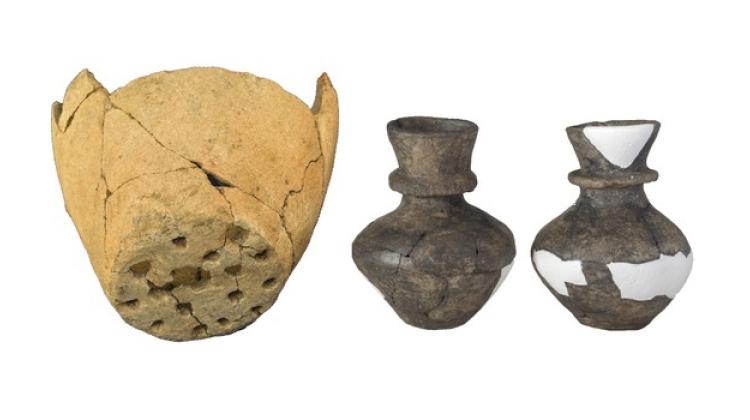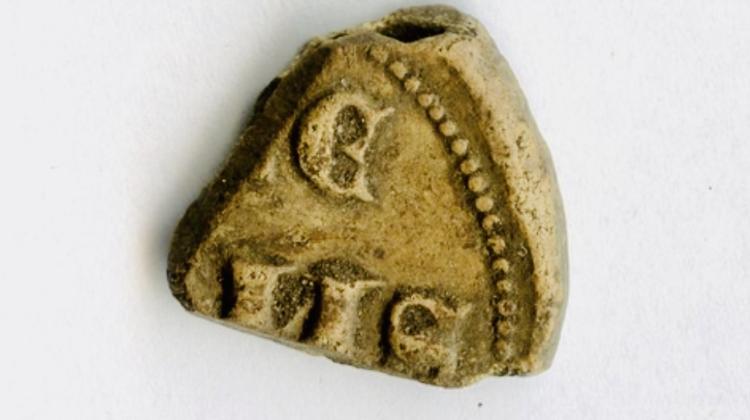Neolithic farmers processed cow, goat and sheep milk, says new study
 Neolithic ceramics identified with high curd-content residues. Credit: University of York (UK)
Neolithic ceramics identified with high curd-content residues. Credit: University of York (UK)
Farmers living in today’s Poland during the Neolithic period produced dairy products from the milk of various animals: cows, sheep and goats. This was confirmed by analyses of residues from clay vessels found in the Kujawy-Pomerania Province. The research results have been published in the Royal Society Open Science.
The research and publication authors are scientists from the UK and Poland - the Nicolaus Copernicus University in Toruń and the Institute of Systematics and Evolution of Animals of the Polish Academy of Sciences in Krakow.
Dr. Harry Robson from the Department of Archaeology at the University of York said: “These results contribute significantly to our understanding of the use of dairy products by some of the earliest farmers of Central Europe.
“Whilst previous research has shown that dairy products were widely available in some European regions during this period, here, for the first time, we have clear evidence for a diversified dairy herd, including cattle, sheep and goats, from the analysis of ceramics.”
The tested vessels come from the vicinity of the village of Sławęcinek (Kujawy-Pomerania). They were discovered in 2016 during rescue excavations. In the Late Neolithic layer (ca. 3650–3100 years ago) archaeologists found not only ceramic vessels, but also traces of a small settlement with four houses, wells and burials.
The researchers used a multi-stranded proteomic and lipid-analysis approach to investigate ceramics and deposits on their surface.
Cheesemaking (and other curd-enriching dairy processing) can be directly detected by scrutinising the proportion of curd proteins, by comparing proteomic data.
Lead author of the study, Miranda Evans from the Department of Archaeology at Cambridge said: “Proteomic results showed that the ancient residues (from vessels - PAP) closely resembled both the modern cheesemaking residues and cheese itself and not whole milk. This reveals that the people of Sławęcinek practised cheesemaking or another form of curd-enriching dairy processing.”
Further evidence of multiple species used for cheesemaking was the presence of both cow and sheep or goat bones on the archaeological site.
In the Neolithic, lactose intolerance was a common phenomenon - it affected almost every inhabitant of Europe until the Late Bronze Age when the genetic mutation became widespread, enabling adults to produce lactase, the enzyme which breaks down lactose in the body. At the same time, cattle farmers learned to reduce the lactose content in milk by processing it into cheese or, for example, yoghurt.
Evidence for the consumption of dairy products includes the remains of vessels with 'milk residues' preserved from those times in various regions. A similar argument are dairy proteins found in the dental plaque of Neolithic humans. There are also bones of cattle with kill patterns expected for dairy animals.
Archaeologists have increasing evidence that milk has been consumed in Central Europe since the beginning of the Neolithic. Fat particles typical of dairy products were found earlier on ceramic vessels discovered in today's Poland and Hungary. The age of these vessels is estimated at the 6th millennium BCE. Traces of cheese production from over 7,000 years ago years ago were discovered on vessels found in Kujawy. The publication on this subject, by British, American and Polish scientists, was published in Nature in 2012 (more - HERE). (PAP)
Anna Ślązak
zan/ agt/ kap/
tr. RL
Przed dodaniem komentarza prosimy o zapoznanie z Regulaminem forum serwisu Nauka w Polsce.
















